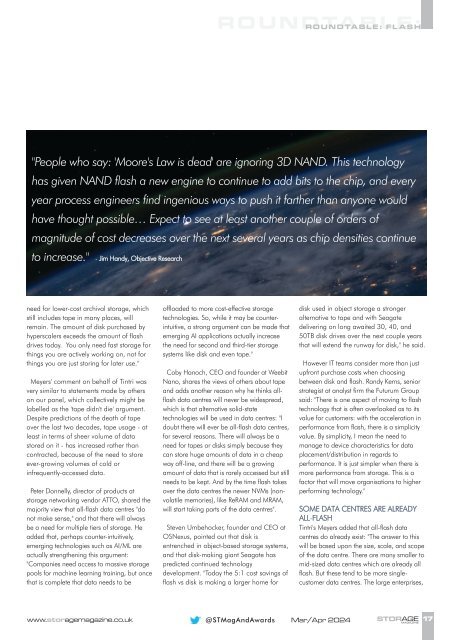ST2403
You also want an ePaper? Increase the reach of your titles
YUMPU automatically turns print PDFs into web optimized ePapers that Google loves.
ROUNDTABLE: FLASH<br />
"People who say: 'Moore's Law is dead' are ignoring 3D NAND. This technology<br />
has given NAND flash a new engine to continue to add bits to the chip, and every<br />
year process engineers find ingenious ways to push it farther than anyone would<br />
have thought possible… Expect to see at least another couple of orders of<br />
magnitude of cost decreases over the next several years as chip densities continue<br />
to increase." - Jim Handy, Objective Research<br />
need for lower-cost archival storage, which<br />
still includes tape in many places, will<br />
remain. The amount of disk purchased by<br />
hyperscalers exceeds the amount of flash<br />
drives today. You only need fast storage for<br />
things you are actively working on, not for<br />
things you are just storing for later use."<br />
Meyers' comment on behalf of Tintri was<br />
very similar to statements made by others<br />
on our panel, which collectively might be<br />
labelled as the 'tape didn't die' argument.<br />
Despite predictions of the death of tape<br />
over the last two decades, tape usage - at<br />
least in terms of sheer volume of data<br />
stored on it - has increased rather than<br />
contracted, because of the need to store<br />
ever-growing volumes of cold or<br />
infrequently-accessed data.<br />
Peter Donnelly, director of products at<br />
storage networking vendor ATTO, shared the<br />
majority view that all-flash data centres "do<br />
not make sense," and that there will always<br />
be a need for multiple tiers of storage. He<br />
added that, perhaps counter-intuitively,<br />
emerging technologies such as AI/ML are<br />
actually strengthening this argument:<br />
"Companies need access to massive storage<br />
pools for machine learning training, but once<br />
that is complete that data needs to be<br />
offloaded to more cost-effective storage<br />
technologies. So, while it may be counterintuitive,<br />
a strong argument can be made that<br />
emerging AI applications actually increase<br />
the need for second and third-tier storage<br />
systems like disk and even tape."<br />
Coby Hanoch, CEO and founder at Weebit<br />
Nano, shares the views of others about tape<br />
and adds another reason why he thinks allflash<br />
data centres will never be widespread,<br />
which is that alternative solid-state<br />
technologies will be used in data centres: "I<br />
doubt there will ever be all-flash data centres,<br />
for several reasons. There will always be a<br />
need for tapes or disks simply because they<br />
can store huge amounts of data in a cheap<br />
way off-line, and there will be a growing<br />
amount of data that is rarely accessed but still<br />
needs to be kept. And by the time flash takes<br />
over the data centres the newer NVMs (nonvolatile<br />
memories), like ReRAM and MRAM,<br />
will start taking parts of the data centres".<br />
Steven Umbehocker, founder and CEO at<br />
OSNexus, pointed out that disk is<br />
entrenched in object-based storage systems,<br />
and that disk-making giant Seagate has<br />
predicted continued technology<br />
development. "Today the 5:1 cost savings of<br />
flash vs disk is making a larger home for<br />
disk used in object storage a stronger<br />
alternative to tape and with Seagate<br />
delivering on long awaited 30, 40, and<br />
50TB disk drives over the next couple years<br />
that will extend the runway for disk," he said.<br />
However IT teams consider more than just<br />
upfront purchase costs when choosing<br />
between disk and flash. Randy Kerns, senior<br />
strategist at analyst firm the Futurum Group<br />
said: "There is one aspect of moving to flash<br />
technology that is often overlooked as to its<br />
value for customers: with the acceleration in<br />
performance from flash, there is a simplicity<br />
value. By simplicity, I mean the need to<br />
manage to device characteristics for data<br />
placement/distribution in regards to<br />
performance. It is just simpler when there is<br />
more performance from storage. This is a<br />
factor that will move organisations to higher<br />
performing technology."<br />
SOME DATA CENTRES ARE ALREADY<br />
ALL-FLASH<br />
Tintri's Meyers added that all-flash data<br />
centres do already exist: "The answer to this<br />
will be based upon the size, scale, and scope<br />
of the data centre. There are many smaller to<br />
mid-sized data centres which are already all<br />
flash. But these tend to be more singlecustomer<br />
data centres. The large enterprises,<br />
www.storagemagazine.co.uk<br />
@STMagAndAwards Mar/Apr 2024<br />
STORAGE<br />
MAGAZINE<br />
17
















